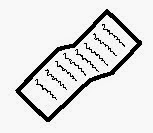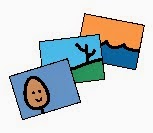While we are waiting, there are often things that we can do to keep everything moving along and to get prepared for what lies ahead. In the world of AAC, here are a few suggestions of ways that we can keep taking those steps forward.
What can I do now?
When you have to wait for an assessment or for AAC services to "begin" for your child, ask your service provider about what you can be doing to get ready. There are a variety of service pathways at the children's treatment centres across Ontario. Often the process is outlined on the Centres' websites.
At TVCC in London, Ontario, parents and caregivers of children who have been referred are encouraged to complete an Augmentative Communication Orientation online learning module, where they learn about what's involved in the assessment process. Families may also participate in a Discovery Consultation at which information related to their child's existing communication skills is shared. If their child then needs to wait for an assessment, suggestions are made for some introductory "next steps" that can help that child continue to develop their communication skills while waiting for an appointment.
Gathering information...
You may be asked to gather together information that will ultimately be used when service providers are beginning their involvement. Some of this information can be helpful in many different situations: informing a new teacher about how your child communicates, sharing information with a support worker in the home, providing an update to a medical specialist at your next appointment.
Here are a few ways to pull all of that information together:
- Observe your child and document what you see. Your child will have lots of different ways that they use right now to let you know how they're feeling or what they want to do. If you can list what your child does and what it means, it can be very helpful to others who are just getting to know them for the first time. Sometimes this list of communication strategies used is referred to as a "Communication Dictionary".
- List your child's preferences e.g. favourite toys, books, movies, activities. When thinking about setting up opportunities for practicing communication, AAC clinicians will often want to engage your child in activities that are highly motivating. Knowing what items your child doesn't like can be equally important, as there are times when we need to know if a child is making a request for an item with intent ("I'm looking at my favorite stuffy. I really want it.") vs. looking at an item because you have held it up ("I'm looking at the empty kleenex box").
- Considering your child's preferences is a great starting point for documenting vocabulary that you think will need to be added to any communication system that is put in place. Start to keep a note of those key words that will be motivating for your child - the names of pets or best buddies, places that they love to visit, expressions that your family likes to use. The list that you generate can later be used as a starting point for customizing a vocabulary on a speech generating device or personal communication display.
Thinking about funding...
When looking ahead to putting in place communication strategies, there may be items that are recommended to be purchased or leased following the assessment. Many funding sources require documentation from a doctor stating a child's diagnosis. It will be helpful to obtain this from your doctor ahead of time. Information about potential funding sources is often available through a local children's treatment centre. In London, Ontario, TVCC funding information can be found here.
Sharing Information...
- Put your observations into an "About Me Book". You can make it as fancy or as straightforward as you want. Sharing information about how your child communicates can provide the context needed for successful communication. It can also be used to share interests and spark conversation.
- Another way of collecting all of this information is by creating a "Communication Passport". Download a template that can be customized and printed out.
- Create a "Remnant Book". This is a place to store photos, postcards, tickets or mementos that are meaningful to someone. This provides a way to talk about things that are fun or important to the person and allows others to get to know them better. Many families use a small photo album that can be easily transported or attached to a wheelchair with a clip.
A picture is worth a thousand words...
Capture some examples of how your child is currently communicating on a phone or tablet. This can be a very helpful tool when introducing your child to new people. Not only does it show what your child is capable of, it can also show new communication partners how they can best interact with your child (e.g. how to ask questions, how to interpret responses). These days you can gather all your information together in a high tech manner - capture the information for your communication passport in a Prezi that others can watch and learn from. Here's a brilliant example, all about Abby!

Shape your child's yes and no responses. Having a consistent, repeatable and recognizable way to say "yes" and "no" can be very helpful when your child is communicating with a variety of different people. There are lots of ways that you can say "yes" and "no" - a head movement, a gesture, moving your eyes a certain way, etc. In addition, we sometimes use different methods at different times to 'say' these words. Our students often benefit from clear feedback about what they have done that has been accepted as a "yes" or "no" response: "I see you looking right at me - I think you are telling me yes". Share with others what has worked and what you are looking for as a "yes" and "no" response - make sure it's listed in your communication dictionary and passport!
For additional ideas for shaping yes/no responses, check the Teaching Learners with Multiple Needs blogspot.
Modeling...
Here's something that you can start doing as soon as symbols are introduced for your child. Pointing to symbols as you speak helps kids understand what symbols mean and how they can be used. It sounds like a simple enough idea, but requires us to change how we interact with our children. The PRC Let's Talk Blog has a wonderful post by Beth Ahmad that explains why we need a "Model, Model, Model" Mantra.
Learning locally...






